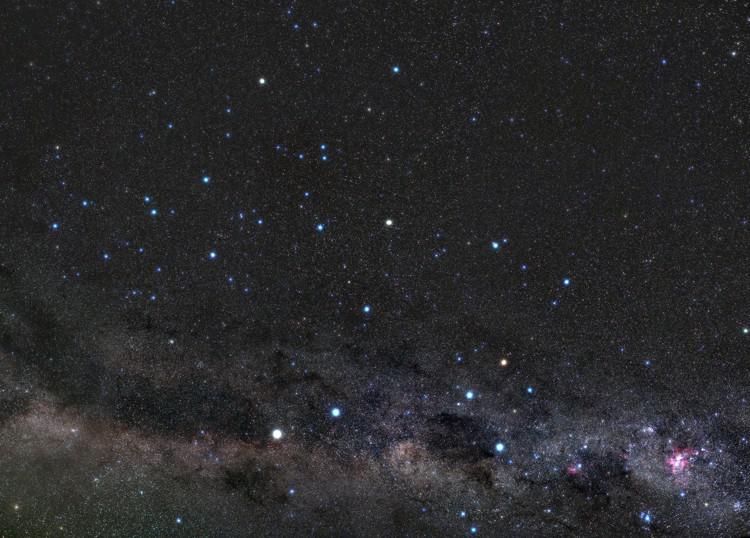This page describes an image Cen-Lup-Cru-Panorama: Centaurus Carrying the Beast and Riding Along the Milky Way
Caption:
Winner in the 2022 IAU OAE Astrophotography Contest, category Still images of celestial patterns.
This image was taken in February 2020 in the Coquimbo Region along the northern coast of Chile. It is one of the best places on Earth for astronomical observations, thanks to its clear skies, lack of light pollution and lack of precipitation, as it is close to the Atacama desert, one of the driest places on our planet. It is no coincidence that many of the most modern professional observatories are located here. The picture shows prominent patterns visible in the southern latitudes, containing rich cultural significance for various Indigenous groups of the southern world. In the bottom of the image towards the right, the Southern Cross is prominent. The orange star at the top of the Southern Cross is called Gacrux (gamma crux). The people in Chile celebrate the beginning of winter at the beginning of May when the constellation Crux is high up in the sky; for them it is a symbol of the start of the cold season. For the festival of the Cruz de Mayo (the Great Cross), they put candles next to crosses in their villages when the constellation Crux is high. As in Christianity, the four endpoints (stars) of the cross symbolise the cardinal virtues. For some indigenous Chileans, they represent the fundamental cultural principles: force, reciprocity, wisdom, and spirituality.
Unlike modern constellations that are arrangements of several stars, Indigenous peoples sometimes associate stories with individual stars. In the case of the Southern Cross for example, the Boorong, Djab Wurrung and Jardwadjali peoples of Australia refer to the star Gacrux as Bunya (the ring-tailed possum). From the Southern Cross to the left of the image are two bright stars, these are called the pointer stars (as they point to the Southern Cross). The Djab Wurrung and Jardwadjali people refer to the pointer stars as the Bram-bram-bult brothers, who hunted and killed the giant Emu Tchingal. Alpha Centauri, which is the brighter and whiter of the two pointer stars, is the closest star to the Sun that we can see with our eyes, located just over four light-years away. To the bottom left of the Southern Cross is a dark nebula, which the Indigenous Australians see as the head of the Emu Tchnigal (the Coalsack Nebula). The pointers are located on the neck of the Emu. The image also shows two other IAU constellations, Centaurus (The Centaur) and Lupus (The Wolf), and HII regions of the Eta Carina Nebula (seen in pink).
Credit:
Uwe Reichert/IAU OAE
DOI: 10.5281/zenodo.7425316
Related glossary terms:
Constellation
, Milky Way
, Southern Cross
Categories:
Milky Way and Interstellar Medium
, Naked Eye Astronomy
License: Creative Commons Attribution 4.0 International (CC BY 4.0) Creative Commons Attribution 4.0 International (CC BY 4.0) icons
The media file captions presented on the OAE website were written, translated and reviewed by a collective effort from the OAE, the OAE Centers and Nodes, the OAE National Astronomy Education Coordinators (NAECs) and other volunteers. You can find a full list of credits for our translation project here. All media file captions are released under a Creative Commons CC BY-4.0 license and should be credited to "IAU OAE". The media files themselves may have different licenses (see above) and should be credited as listed above under "credit".
Captions in Different Languages:
Caption: Auszeichnung beim IAU OAE Astrofoto-Wettbewerb 2022, Kategorie Weitwinkelaufnahmen von Himmelsmustern.
Dieses Bild wurde im Februar 2020 in der Region Coquimbo an der Nordküste von Chile aufgenommen - einem der besten Plätze auf der Erde für astronomische Beobachtungen, dank des klaren Himmels abseits der Lichtverschmutzung und kaum Niederschlägen in der Nähe der Atacama-Wüste, einem der trockensten Orte auf unserem Planeten. Es ist kein Zufall, dass sich hier viele der modernsten professionellen Observatorien befinden. Das Bild zeigt auffällige Muster am Himmel, die von südlichen Breitengraden aus zu sehen sind und die für verschiedene indigene Gruppen der Südhalbkugel der Erde von großer kultureller Bedeutung sind. Im unteren Teil des Bildes rechts ist das Kreuz des Südens (lat. Crux) zu sehen. Der orangefarbene Stern an der Spitze des Kreuzes des Südens wird Gacrux (gamma Crucis) genannt. Die Menschen in Chile feiern den Winteranfang Anfang Mai, wenn das Sternbild Crux hoch am Himmel steht; für sie ist es ein Symbol für den Beginn der kalten Jahreszeit. Für das Fest des Cruz de Mayo (Großes Kreuz) stellen sie in ihren Dörfern Kerzen neben Kreuzen auf, wenn das Sternbild Crux hoch am Himmel steht. Wie im Christentum symbolisieren die vier Endpunkte (Sterne) des Kreuzes hierbei die Kardinaltugenden. Für einige chilenische Ureinwohner stehen sie aber auch für die grundlegenden kulturellen Prinzipien Kraft, Gegenseitigkeit, Weisheit und Spiritualität.
Im Gegensatz zu modernen Sternbildern, die aus mehreren Sternen zusammengesetzt sind, verbinden indigene Völker manchmal Geschichten mit einzelnen Sternen. Im Fall des Kreuzes des Südens zum Beispiel bezeichnen die Völker der Boorong, Djab Wurrung und Jardwadjali in Australien den Stern Gacrux als Bunya (der Ringelschwanzbeutler). Links vom Kreuz des Südens befinden sich zwei helle Sterne, die als Zeigersterne bezeichnet werden (da sie auf das Kreuz des Südens zeigen). Die Djab Wurrung und Jardwadjali identifizieren die Zeigersterne mit den Bram-Bram-Bult-Brüdern, die den Riesen-Emu Tchingal jagten und töteten. Alpha Centauri, der hellere und weißlichere der beiden Zeigersterne, ist der sonnennächste Stern, den wir mit unseren Augen sehen können, und nur etwas mehr als vier Lichtjahre entfernt. Unten links vom Kreuz des Südens befindet sich ein dunkler Nebel, den die australischen Ureinwohner als den Kopf des Emu Tchnigal (den Kohlensack) betrachten. Die Zeiger befinden sich auf dem Hals des Emu. Das Bild zeigt auch zwei andere IAU-Sternbilder, Centaurus (der Zentaur) und Lupus (der Wolf), sowie HII-Regionen des Eta-Carinae-Nebels (in rosa).
Credit: Uwe Reichert/IAU OAE
Related glossary terms: Kreuz des Südens , Milchstraße , Sternbild Caption translation status: Not yet approved by a reviewer
Caption translators: Carolin Liefke
Caption: Vincitore del concorso di astrofotografia IAU OAE 2022, categoria Immagini fisse di schemi celesti.
Questa immagine è stata scattata nel febbraio 2020 nella regione di Coquimbo, lungo la costa settentrionale del Cile. Si tratta di uno dei luoghi migliori sulla Terra per le osservazioni astronomiche, grazie ai suoi cieli limpidi, alla mancanza di inquinamento luminoso e all'assenza di precipitazioni, poiché si trova vicino al deserto di Atacama, uno dei luoghi più aridi del nostro pianeta. Non è un caso che molti dei più moderni osservatori professionali si trovino qui. L'immagine mostra le principali costellazioni visibili alle latitudini meridionali, che assumono un ricco significato culturale per diversi gruppi indigeni del sud del mondo. Nella parte inferiore dell'immagine, verso destra, spicca la Croce del Sud. La stella arancione in cima alla Croce del Sud è chiamata Gacrux (gamma crux). Gli abitanti del Cile celebrano l'inizio dell'inverno all'inizio di maggio, quando la costellazione della Croce del Sud è alta nel cielo; per loro è un simbolo dell'inizio della stagione fredda. Per la festa della Cruz de Mayo (la Grande Croce), mettono delle candele accanto alle croci nei loro villaggi quando la costellazione della Croce del Sud è alta. Come nel cristianesimo, le quattro estremità (stelle) della croce simboleggiano le virtù cardinali. Per alcuni indigeni cileni, rappresentano i principi culturali fondamentali: forza, reciprocità, saggezza e spiritualità.
A differenza delle costellazioni moderne, che sono composizioni di più stelle, le popolazioni indigene associano talvolta delle storie a singole stelle. Nel caso della Croce del Sud, ad esempio, i popoli australiani Boorong, Djab Wurrung e Jardwadjali si riferiscono alla stella Gacrux come a Bunya (l'opossum dalla coda ad anelli). Dalla Croce del Sud a sinistra dell'immagine ci sono due stelle luminose, chiamate stelle puntatrici (in quanto indicano la Croce del Sud). I popoli Djab Wurrung e Jardwadjali si riferiscono alle stelle puntatrici come ai fratelli Bram-bram-bult, che cacciarono e uccisero il gigante Emu Tchingal. Alpha Centauri, la più luminosa e la più bianca delle due stelle puntamentatrici, è la stella più vicina al Sole che possiamo vedere con i nostri occhi, situata a poco più di quattro anni luce di distanza. In basso a sinistra rispetto alla Croce del Sud si trova una nebulosa scura, che gli indigeni australiani considerano la testa dell'Emu Tchnigal (la nebulosa Sacco di Carbone). Le stelle puntatrici si trovano sul collo dell'Emu. L'immagine mostra anche altre due costellazioni IAU, Centaurus (il Centauro) e Lupus (il Lupo), e le regioni HII della Nebulosa Eta Carina (in rosa).
Credit: Uwe Reichert/IAU OAE
Related glossary terms: Costellazione , Croce del Sud , Via Lattea Caption translation status: Approved by a reviewer
Caption translators: Giuliana Giobbi, Valentina La Parola
Caption reviewers: Rodolfo Canestrari, Raffaella Ferretti









